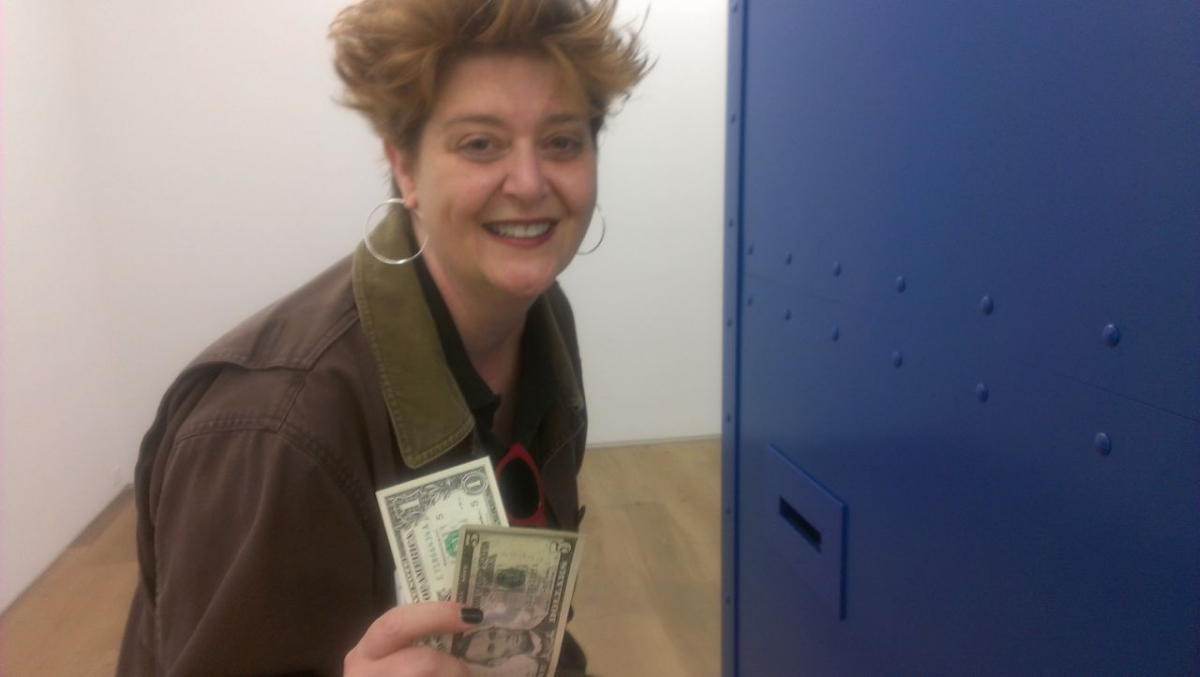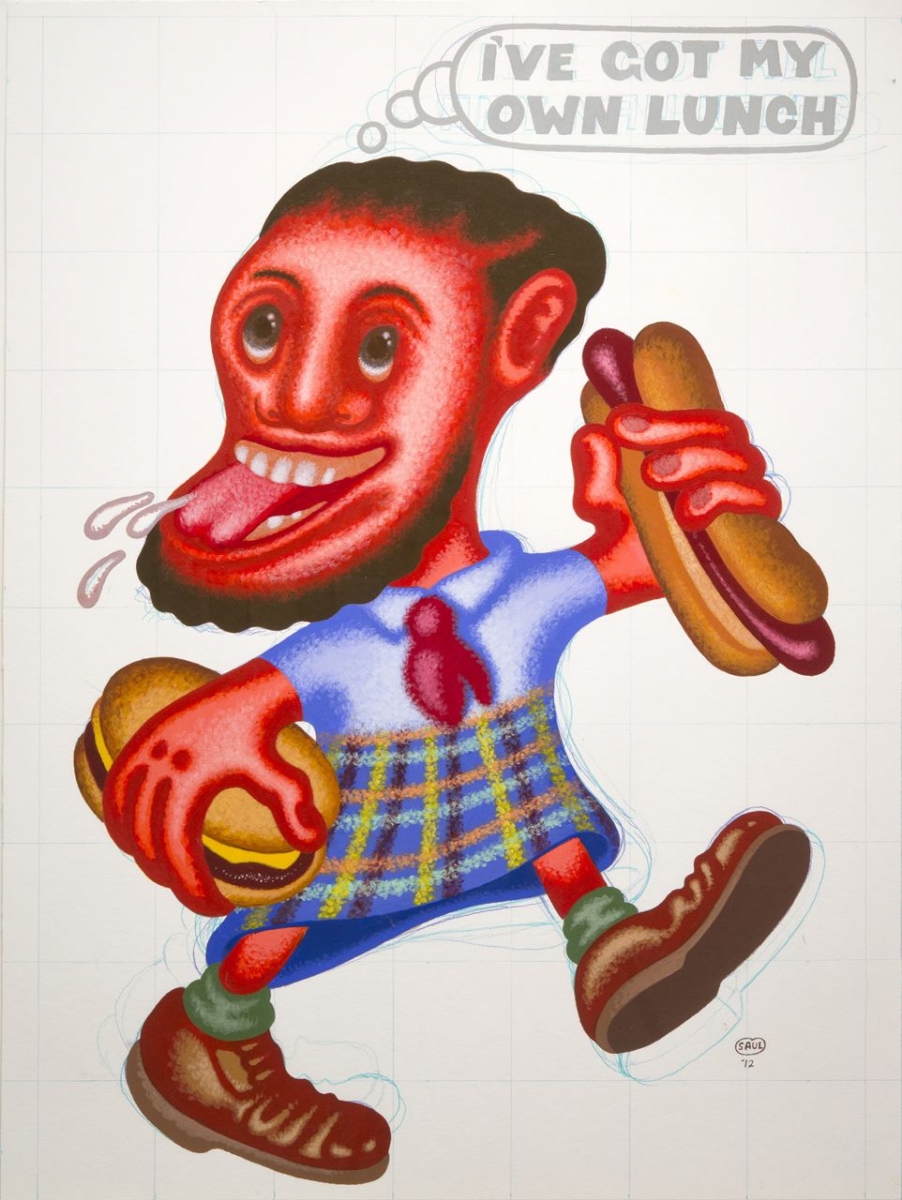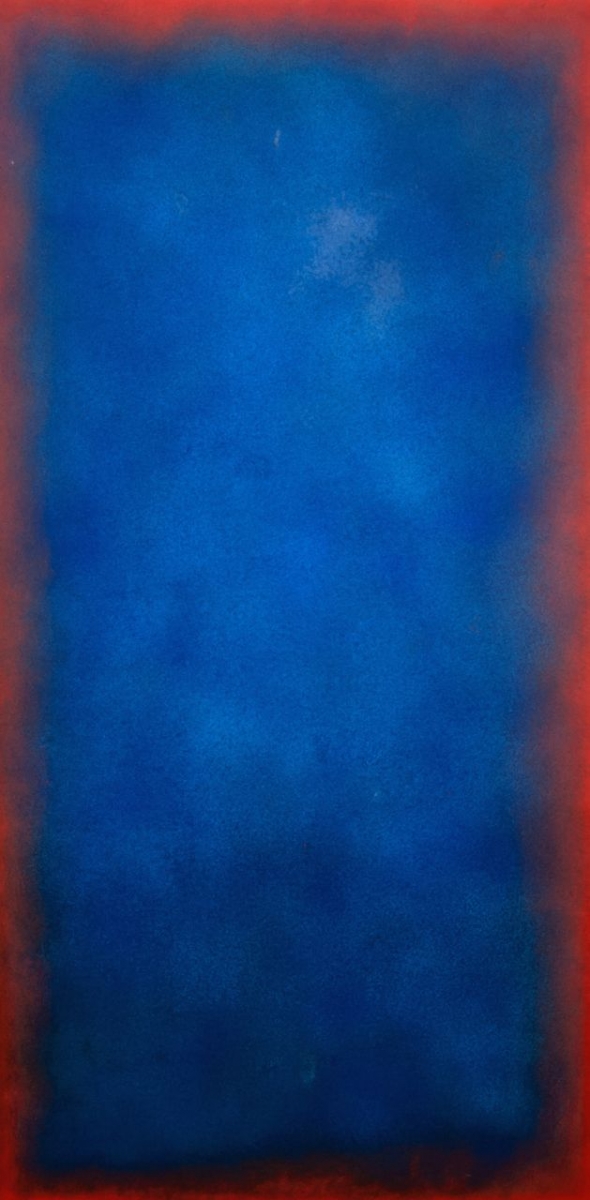
Like sugar-induced hyperactive children, David and I went to the only place where grownups ring doorbells to see art: The Upper East Side. Were we tricked? Yes. Were we treated? Yeah, that too.
Our first stop was Michael Werner Gallery, where their new and stunning second floor space houses a Peter Saul exhibition. This was a treat to see in the temple that is the Upper East Side. I have always thought Saul's work a precursor to Pop-influenced artists such as Kenny Scharf as well as walking lockstep with R. Crumb's social irreverence.
"Good grief, Elizabeth," quipped David, "it was a group show, with the coyly crass title Tumescence. And yet, you’re right to remember Saul over the others (Peter Doig, Sigmar Polke, and Michael Williams) as his was the only work that actually gives evidence of a truly turgid imagination. For me, the best piece was the recent Saul painting 'Head', in the back room, a wonderfully realized surreal image at once monstrous, funny and beautiful, like a Guston on LSD. He’s well quoted in the press release too: "Not to be shocking means to agree to be furniture.'"

"What can I say, David, I go straight for what I like and everybody else be damned. It isn’t the most developed of sensibilities, so now you know."
Our next doorbell was Freedman Art, where in the fourth floor viewing room are beautiful small works by Jules Olitsk;i a colorful but a bit more subdued Natvar Bhavsar exhibition, Energy of Color (image below) is also on the fourth floor. We both agreed that the recent large work that greets one at the entrance, "Sangraha" (2007), was a knockout. David pegged it "as somewhere between a 1950s Mark Rothko and an Otto Piene burn painting, and very much of the color-field school."
Yet the true standout of the Madison Avenue segment for David and I was the Yves Klein installation on the second floor of the exhibition Audible Presence on at the new Dominique Levy Gallery from September 18th through November 16th -- a section of the back floor is covered with Klein's trademark electric blue pigment. It is always impressive that this artist has managed to turn a color into an icon; there will never be anyone like him again. David was equally absorbed by it: "This is one of the earliest installation pieces; it is from 1961. Above the rectangular section of floor densely covered in 'Klein Blue' are a number of similarly painted wooden dowels hung at different heights to simulate rain. The whole has a wonderfully artificial quality that creates an intimate fantasy in real space suitably titled Blue Rain or, if you prefer, 'Pluie Bleue.' I also found the large untitled white sponge painting (1957) by him memorable." Unfortunately, the Levy gallery staff has not sent us an installation view of "Blue Rain."
An abstract portrait of Iris Clert, Lucio Fontana's dealer, is handsomely scraffitoed and literally penetrated by a huge gash through the face and figure. Unmistakably, this piece of precious stone-encrusted "furniture" is a lesson in European crudeness. Indeed, all these works are imbued with the post-war feeling of DADA that sought to oppose pictorial traditions by literalizing them. Thus the modernist taboo of not "penetrating" the picture plane brings us to this expression of sexual contempt!

As earlier, David was absolutely right about my skipping through the rest of the artists on view here too, as I can't seem to be anything but transfixed when it comes to that intense blue. However, sexist expression aside, I was not thrilled with the later work of Fontana, as so many of them seem made by rote; they lost that "punch" the early works have -- what can I say?
Downstairs from the Dominique Levy Gallery was the show at Galerie Perrotin, also new to Madison Avenue though not to Paris, Parrotin only opened its doors recently and with an attention-getter -- Paola Pivi's OK, You Are Better than Me, So What?" (September 18th - October 26th). The show is composed of two installations. Upstairs, various sad-eyed but feather-coated life-sized candy-colored bears. As I gushed over the day-glow colored bears, David turned to me and said, "Confess, Elizabeth, you so want to take one home, they are so F.A.O. Schwartz, with a 'Green' attitude. I wonder how many ducks got plucked to make these Long Island McMansion toys."
Downstairs a large blue metal box titled "Money Machine" (image top) with no rhyme or reason blows out coins and bills onto the floor in the basement of a former bank, which I suppose adds to the joke. It's a parody of the idea of art as an investment. (Caution to collectors: Don't turn it on if you have kids.) After collecting $6.00, David and l caught a cab to Mangia's on 57th Street for a bit of lunch and a coffee -- yep, the six bucks did not quite cover the cab fare, but when else did an artwork ever literally pay the viewer for looking!
Our move downtown took a turn for the figurative with a show at Porter Contemporary Bliss Point of works by Jeff Huntington, October 17th through November 16th. Huntington is exploring the subject of childhood obesity with various mixed media/collage portraits of children composed of splicing certain junk food brands, images, and symbols.
We later found ourselves at Driscoll -- Babcock Galleries for an impressive debut of paintings by Jenny Morgan titled How to Find a Ghost, on view from October 17th to November 23rd. I was most drawn into these larger-than-life nudes by the technique and treatment of the medium. I felt the artist has scrubbed and reapplied the pigment so many times that this treatment has given her models a very raw, translucent quality to the skin. Despite her use of blurring, Morgan's photorealist technique leaves the figures quite naked. An exception was "Mother" (2013), a figure submerged in a luscious red that I cooed over. Still, we both agreed that there is something impressive in this first solo outing of Morgan’s work.
Last of all, at David's suggestion and with no argument from me, we headed to a reception at P.P.O.W. I have followed their program since the 1980s, and they seldom disappoint; on view is Julie Heffernan's Sky is Falling, October 17th through November 16th, and it was no exception. A series of beautifully painted scenes setting her subjects in a surreal environment from which they seem to trying to escape; I love this show.
While David enjoyed looking at the Morgan paintings, he was engrossed with Heffernan's. At one point he turned his eyes away from "Self Portrait as Catastrophic Failure" (2013) and said, "You know this new work puts me in mind of the Enlightenment polymath Jan Potocki, the author of The Manuscript Found in Saragossa. Each of Heffernan’s interiors and landscapes continuously opens into a world within a world, like Potocki’s stories within stories, and each painting presents the dark side of our collective 'technologically smart' economies. These new landscapes present a world view fuelled by a sensibility driven by Heffernan's typical "horror vacui" that has its closest antecedent in Gustave Moreau, the great subversive symbolist painter. And like him, Heffernan continues to experiment with the way she develops a painting using splattered fields of color to generate suggestions of what will appear. And this new group of works has an altogether new feeling for color as affect, an exciting shift from her earlier tonalism."
"For a moment, I thought you were talking about the former Governor. When do you find time to read such obscure stuff?"
As the crowd thickened, we left the opening satisfied with our day’s collection of treats, despite the excess of candy corn. - Elizabeth Stevens with David Carbone
Ms. Stevens has been in Art and Antiques for 30 years, from representing her family's auction house in Cincinnati to Import Director at Hedley's New York in the early '90s to Salander O' Reilly Galleries, organizing art fairs and traveling exhibitions for more than 12 years. She is the former director of Yellow Bird Gallery in Newburgh, NY as well as the former Exhibitions Curator for the Thomas Cole House. She is now the owner of Elizabeth Stevens & Co. with offices in New York, New Jersey, and soon Florida.
Mr. Carbone is a painter, a critic, a curator and an educator. He has shown nationally in galleries and museums; written for Modern Painters and The Sienese Shredder anthologies, among other publications; occasionally appeared on NPR's Morning Edition with David D'Arcy between 1992-2005; and curated selected retrospectives. He is currently the director of graduate studies in studio arts at the University at Albany, where he teaches painting.
